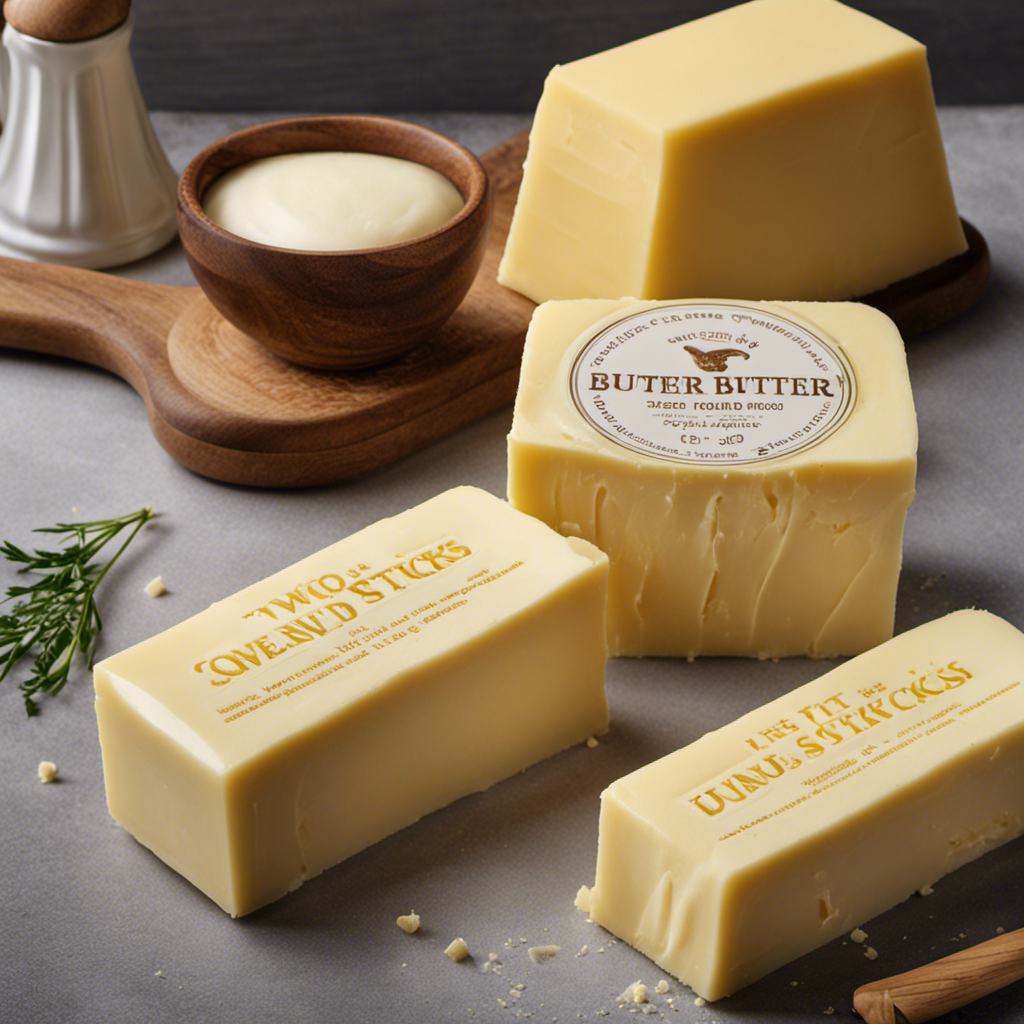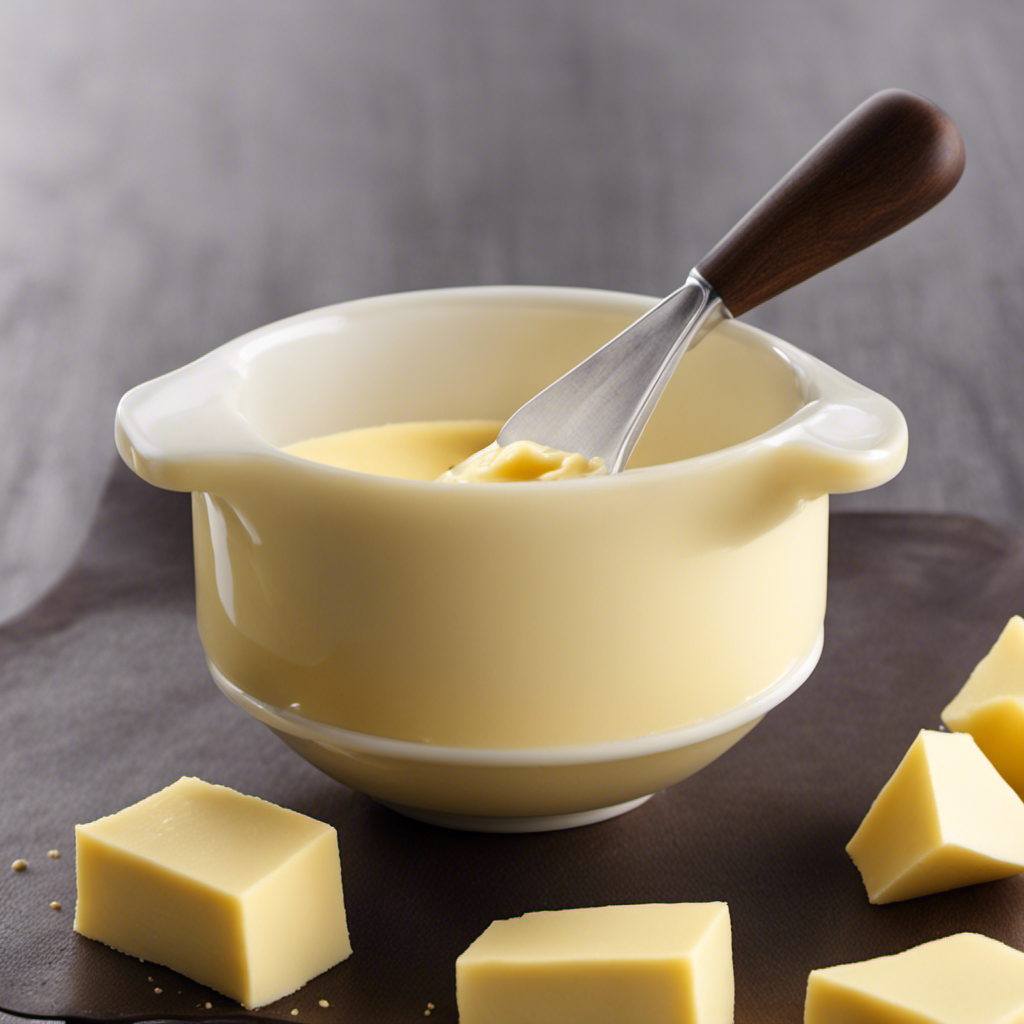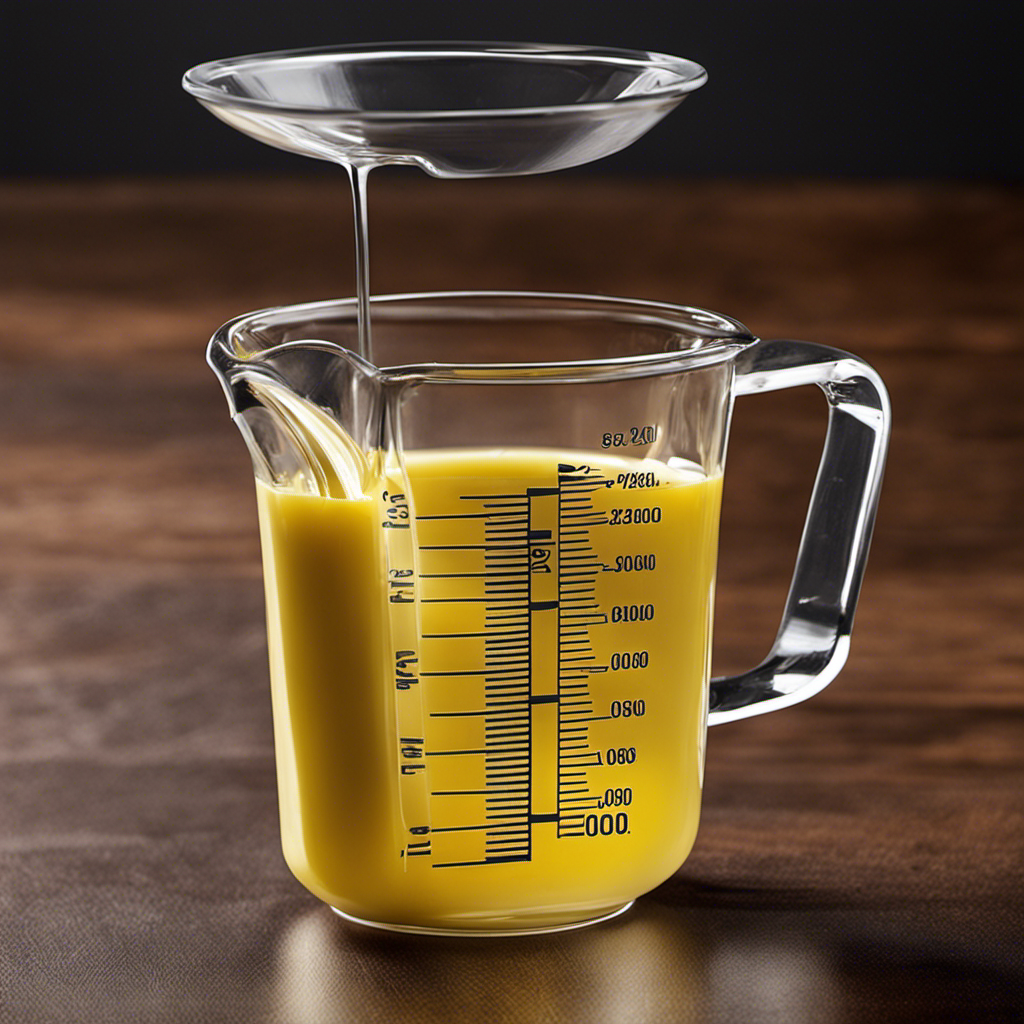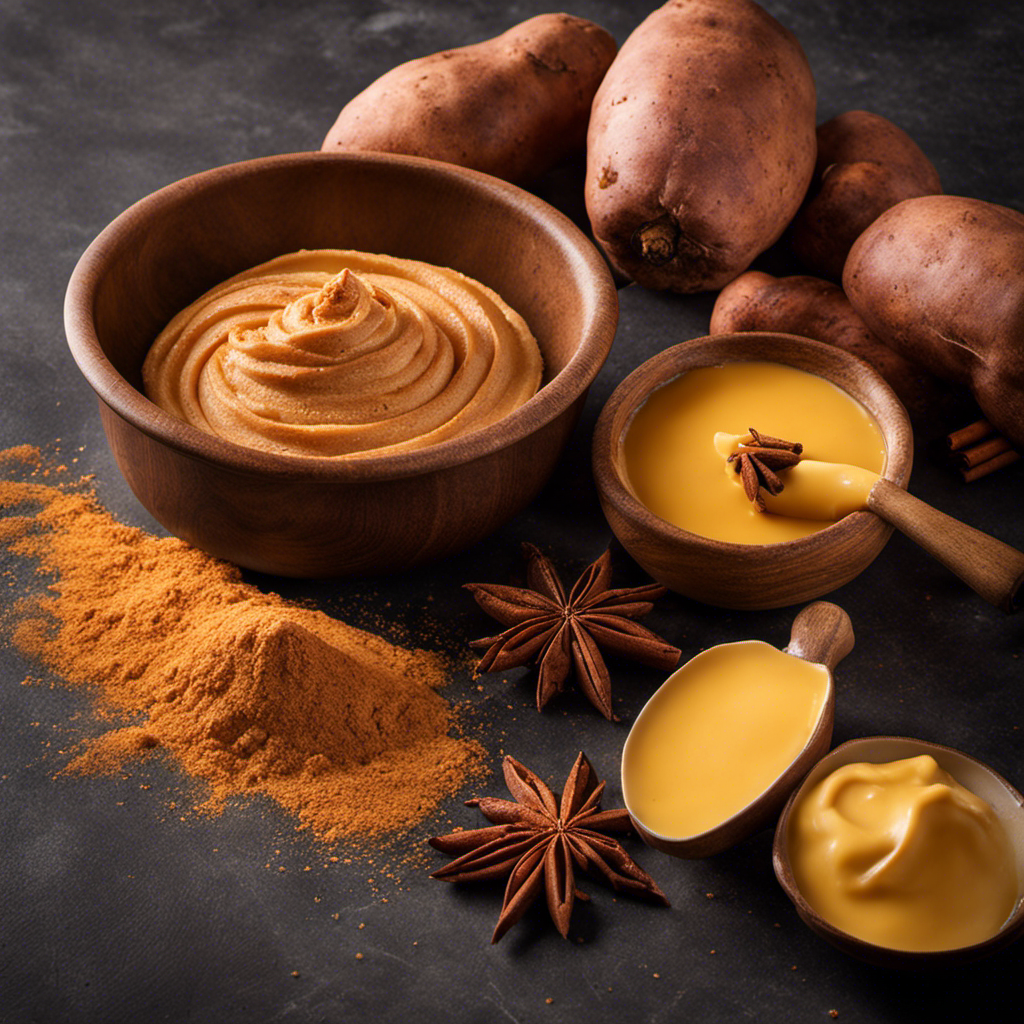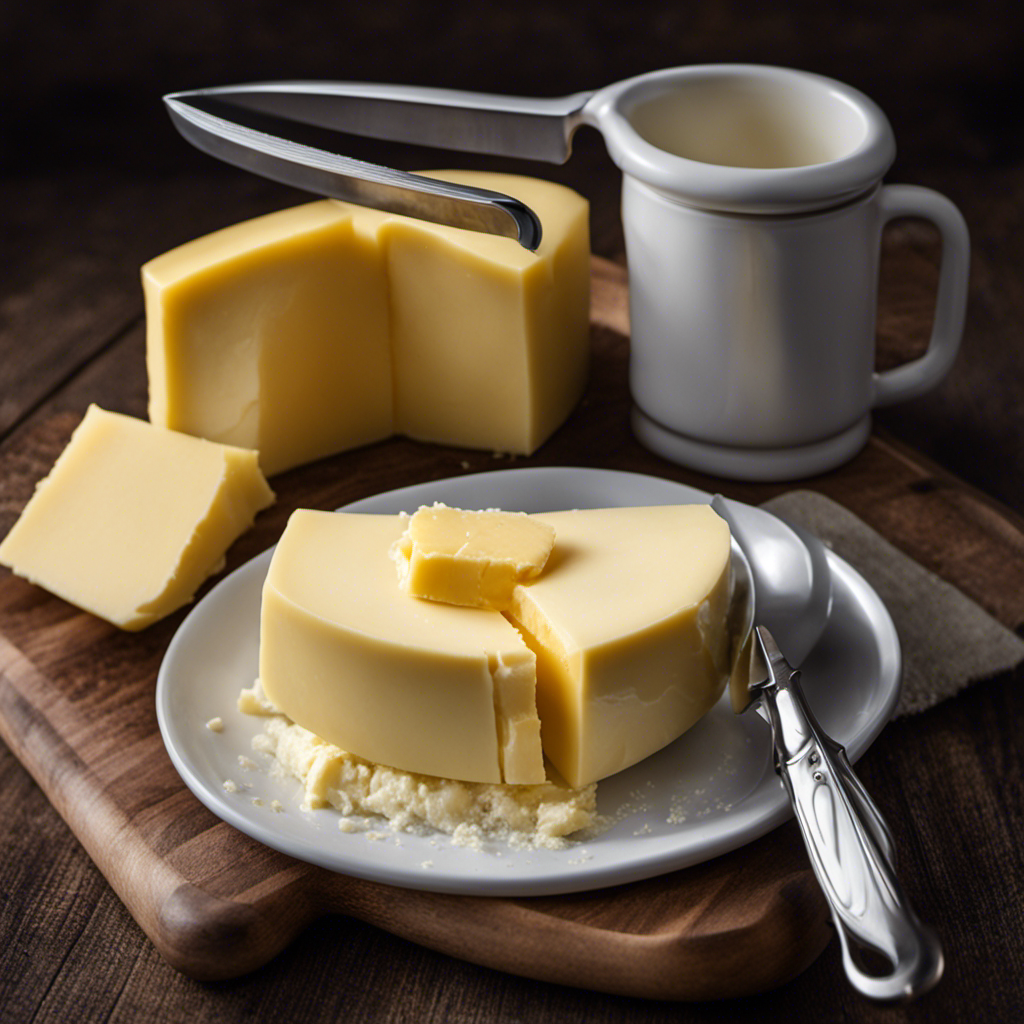Being a food lover, I frequently find myself pondering the quantities of butter required in recipes.
So, let’s dive into the world of butter measurements and uncover the answer to the burning question: how many ounces are in a stick of butter?
In this article, we’ll explore the standard size of a butter stick, learn how to convert sticks to ounces, and discover the precise measurement of a single stick.
So, if you’re ready to master the art of measuring butter for your recipes, let’s get started!
Key Takeaways
- A standard stick of butter weighs 4 ounces or 113 grams in the United States, but the weight can vary in different countries.
- Conversions for butter sticks to ounces can be helpful in recipes, with a quarter stick being 4 ounces, a half stick being 8 ounces, and a full stick being 16 ounces.
- When converting to fluid ounces, one stick of regular butter is equal to 4 fluid ounces, while one stick of European-style butter is equal to 3.5 fluid ounces.
- It is important to familiarize yourself with butter measuring equivalents and conversions to ensure accuracy in recipes.
Understanding Butter Measurements
You might be wondering how many ounces are in a stick of butter. Understanding butter packaging and the different types of butter measurements can help clarify this.
Butter is typically sold in sticks, boxes, or tubs. A stick of butter is a convenient measurement for baking and cooking, as it is easy to use and measure. In the United States, a standard stick of butter weighs 4 ounces or 113 grams.
It is important to note that butter measurements can vary in different countries. For example, in Australia, a standard stick of butter weighs 250 grams. So, when it comes to understanding butter measurements, it is crucial to consider the country’s standard size of a butter stick.
The Standard Size of a Butter Stick
There’s a reason why a stick of butter is a common measurement in recipes. The standard size of a butter stick is 1/2 cup, which is equivalent to 8 tablespoons or 4 ounces.
It is important to note that the size and weight of a butter stick can vary depending on where you are located. In the United States, a stick of butter is typically 4 ounces or 113 grams. However, in some European countries, butter sticks can weigh 250 grams or 8.8 ounces.
To ensure accuracy in your recipes, it is always best to refer to the specific measurements provided in the recipe.
Now, let’s delve into the process of converting butter sticks to ounces to further understand this common measurement in cooking.
Converting Butter Sticks to Ounces
When it comes to measuring butter sticks, it’s important to know the standard size.
A typical stick of butter is 1/2 cup or 4 ounces, which is equivalent to 8 tablespoons.
However, if you need to convert butter sticks to fluid ounces, you’ll need to consider the density of butter.
The density of butter is about 0.9586 grams per milliliter.
Butter Stick Measurement
In the US, there are 4 ounces in a stick of butter. When it comes to butter stick sizes, it’s important to understand the equivalency of each size. To help you understand better, I have created a table below:
| Butter Stick Size | Ounces |
|---|---|
| Quarter | 4 |
| Half | 8 |
| Full | 16 |
As you can see, a quarter stick of butter is equal to 4 ounces, a half stick is equal to 8 ounces, and a full stick is equal to 16 ounces. This information is crucial when following recipes that require specific amounts of butter. By knowing the butter stick equivalency, you can easily measure the correct amount of butter needed for your culinary endeavors.
Converting to Fluid Ounces
To convert a stick of butter to fluid ounces, you can use the table provided to determine the equivalent measurement.
The conversion from sticks to fluid ounces can be a bit tricky, as it depends on the type of butter being used.
For regular salted or unsalted butter, one stick is equal to 4 fluid ounces. However, for European-style butter, which has a higher fat content, one stick is equal to 3.5 fluid ounces.
It is important to note that fluid ounce conversions may vary depending on the brand and type of butter.
To convert to metric measurements, one fluid ounce is equal to 29.57 milliliters. Therefore, one stick of regular butter is approximately 118.29 milliliters, while one stick of European-style butter is approximately 103.52 milliliters.
How Many Ounces in a Single Stick of Butter
There’s typically 4 ounces in a single stick of butter. When it comes to conversions and butter packaging, it’s important to understand the standard measurements used in the industry. To further illustrate this, I have created a table below:
| Packaging Size | Ounces |
|---|---|
| Stick of Butter | 4 |
| Tub | 8 |
| Pound | 16 |
| Bulk | 32 |
As you can see, a stick of butter contains 4 ounces. However, if you prefer to buy butter in larger quantities, you can opt for a tub, which typically holds 8 ounces. Alternatively, a pound of butter weighs 16 ounces, and if you require even more, there are bulk options available, with a whopping 32 ounces of butter. Understanding these measurements can help you accurately convert and package butter for your culinary needs.
Measuring Butter for Recipes
When measuring butter for recipes, it’s important to consider the desired amount needed for the specific dish. To ensure accuracy, it is helpful to be familiar with butter measuring equivalents and butter conversion.
Here are two key points to keep in mind:
-
Stick of Butter: The most common way to measure butter is by using sticks. In the United States, a standard stick of butter weighs 4 ounces or 113 grams. It is important to note that butter sticks may vary in size in different countries.
-
Tablespoon Measurement: Another method of measuring butter is by using tablespoons. One stick of butter is equal to 8 tablespoons or half a cup. This can be useful when a recipe calls for a specific amount of butter in tablespoons.
Tips for Using Butter in Baking and Cooking
When it comes to baking, the temperature of the butter plays a crucial role in achieving the desired results.
It is important to know when to use softened butter, which should be pliable but not melted, and when to use chilled butter, which helps create a flaky texture in pastries.
Additionally, if you happen to run out of unsalted butter, there are a few substitutes you can use, such as margarine or shortening, but it’s important to consider their impact on flavor and texture.
Lastly, proper butter storage is essential to maintain its freshness and prevent it from going rancid. Storing butter in an airtight container in the refrigerator is the best way to preserve its quality and extend its shelf life.
Butter Temperature for Baking
To achieve the best results in baking, it’s important to consider the temperature of the butter. The temperature of the butter plays a crucial role in achieving the desired texture and consistency in baked goods. When butter is too cold, it doesn’t mix well with other ingredients and can result in a dense or lumpy batter. On the other hand, when butter is too warm, it can cause the dough to spread excessively during baking.
To ensure the perfect butter temperature, it is essential to understand its melting point and consistency.
-
Butter melting point: The melting point of butter is around 90°F to 95°F (32°C to 35°C). This temperature allows the butter to soften and blend smoothly with other ingredients without becoming too runny.
-
Butter consistency: Butter should be at room temperature, around 65°F to 70°F (18°C to 21°C), for most baking recipes. At this consistency, it is pliable and easily creamed with sugar, resulting in a light and fluffy texture.
Substitutes for Unsalted Butter
When it comes to baking, unsalted butter is often a crucial ingredient. However, there may be times when you run out of it or need to find a substitute for dietary reasons. Thankfully, there are several alternatives that can be used as substitutes for unsalted butter in your recipes.
One option is margarine, which is made from vegetable oils and has a similar texture and taste to butter. Another alternative is coconut oil, which can be used as a 1:1 replacement for butter in most recipes. Additionally, you can try using alternative spreads like almond or cashew butter, which can add a unique flavor to your baked goods.
It’s important to note that these substitutes may slightly affect the texture and taste of your final product, so it’s always a good idea to experiment and adjust the recipe accordingly.
Butter Storage Tips
One way to keep your butter fresh and prevent it from spoiling quickly is by storing it in an airtight container in the refrigerator. This helps to maintain the flavor and texture of the butter for a longer period. When choosing a butter storage container, it is important to opt for one that is specifically designed for this purpose. Look for containers that are made of food-grade materials and have a tight seal to prevent any air or moisture from getting in. Additionally, consider using butter dishes with built-in lids, as they offer convenience and ensure proper storage.
To soften butter quickly, there are a few methods you can try. One option is to cut the butter into small pieces and leave them at room temperature for about 30 minutes. Another method is to grate the butter using a cheese grater, which allows it to soften faster. You can also use the microwave, but be cautious and heat it in short intervals to avoid melting it completely. Remember, the key is to soften the butter, not to melt it.
Frequently Asked Questions
Can I Use Margarine Instead of Butter in Recipes?
Yes, you can use margarine instead of butter in recipes. However, there are some pros and cons to consider. Margarine may affect the texture and flavor of baked goods differently than butter. It is important to adjust the measurements and choose a suitable type of margarine for your specific recipe.
How Do I Measure Butter if I Don’t Have a Kitchen Scale?
When I don’t have a kitchen scale, I find alternatives to measuring butter. One way is to convert the measurements using tablespoons or cups. It’s a precise technique that ensures accurate results in recipes.
Can I Freeze Butter Sticks for Long-Term Storage?
Yes, you can freeze butter sticks for long-term storage. Freezing is one of the best butter storage options. It helps maintain freshness and prevents spoilage. Be sure to wrap the sticks tightly to prevent freezer burn.
How Many Tablespoons Are in a Stick of Butter?
When it comes to the question of how many tablespoons are in a stick of butter, it’s important to consider the substitute margarine and the desired butter consistency.
What Is the Difference Between Salted and Unsalted Butter?
Salted and unsalted butter differ in their sodium content. Salted butter contains added salt, while unsalted butter does not. In terms of health, unsalted butter may be considered healthier as it allows for better control of sodium intake.
Conclusion
In conclusion, it’s important to understand the measurements of butter, especially when following recipes.
A stick of butter typically weighs 4 ounces or 113 grams. This standard size makes it easier to measure and ensures accurate results in baking and cooking.
While some may argue that using precise measurements is unnecessary, it’s essential for achieving the desired taste and texture in your dishes.
So next time you’re in the kitchen, be sure to measure your butter accurately for the best culinary experience.

